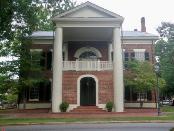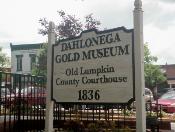

ExploreSouthernHistory.com - Dahlonega Gold Museum, Georgia
ExploreSouthernHistory.com - Dahlonega Gold Museum, Georgia

| Dahlonega Gold Museum The old Lumpkin County Courthouse, built in 1836, now houses the Dahlonega Gold Museum, where visitors can learn the history of Georgia gold mining. |
Dahlonega Gold Museum
The old courthouse holds a
unique spot in history. The
phrase "There's gold in them
there hills!" originated here.
The old courthouse holds a
unique spot in history. The
phrase "There's gold in them
there hills!" originated here.

Lumpkin County Courthouse
The building was completed
in 1836 and is the oldest
standing courthouse structure
in Georgia.
The building was completed
in 1836 and is the oldest
standing courthouse structure
in Georgia.


Georgia Gold
An interpretive panel outside
the Dahlonega Gold Museum
details the history of Georgia
gold mining.
An interpretive panel outside
the Dahlonega Gold Museum
details the history of Georgia
gold mining.
Dahlonega Gold Museum Historic Site - Dahlonega, Georgia
History of Gold Mining in Georgia
| Copyright 2012 by Dale Cox All rights reserved. Last Update: July 28, 2012 |


Custom Search

Dahlonega Gold Museum
The museum is located on
the square in Dahlonega,
surrounded by a historic
downtown noted for its unique
shops and restaurants.
The museum is located on
the square in Dahlonega,
surrounded by a historic
downtown noted for its unique
shops and restaurants.



The Dahlonega Gold Museum Historic Site in
Georgia is one of America's most unique
landmarks.
Located on the square in Dahlonega, it is
housed in the historic old Lumpkin County
Courthouse, built in 1836. It was here, local
legend proclaims, that an assayer first used
the line, "There's gold in them there hills!"
The phrase is now embedded in the history
not only of Dahlonega and the mountains of
Georgia, but of the nation as a whole. It was
used by Mark Twain and an internet search of
the phrase in late 2011 produced 522,000
results! The corrupted version, "Thar's gold in
them thar hills!," returned more than 200,000
more.
Rarely has a single spoken sentence
attained such note! But there is much more
to the history detailed by the Dahlonega Gold
Museum.
The Spanish explorer Hernando de Soto
entered the Blue Ridge Mountains in 1540,
having heard stories from various Indian
groups that there was, as the phrase later
claimed, "gold in them there hills!"
De Soto did not find gold, but was told it
could be found in a place called Chisca. He
was unable to take his many army there. The
land was thinly populated and food was
scarce, the Indians said. They also reported
that the inhabitants were cannibals and there
were "mountain ridges which the horses
could not cross."
A scouting party sent by the conquistador did
find country that looked favorable for gold
mines.
Rumors of gold mines in the mountains
were reported by numerous other early
explorers of the South. It would take nearly
300 years, however, before they were found.
While there is some dispute over the exact
year and location of the first strike in Georgia,
a report prepared for a U.S. Congress sub-
committee in 1831 indicates that it took place
about 30 miles north of Gainesville near the
Chattahoochee River. This supports the
claims of both Dahlonega and Auraria that
gold was first found in the vicinity.
The report goes on to note that by 1829, the
nation's first big gold rush was underway,
with as many as 3,000 miners working in the
Georgia mountains.
Since so many men had learned of the gold
discovery and made their way into the remote
mountains by the summer of 1829, it seems
likely that local legend is correct in its claim
that the first strike was made in 1828.
Early eyewitnesses described how "gold
fever" gripped men in the North Georgia
mountains for years to come. And with good
reason, there was definitely gold there.
Most of the early mining was done by
panning or light digging along the streams,
creeks and rivers of the region. The 1831
report indicated that hundreds of thousands
of dollars in gold had already been taken
from the mountains and there was every
reason to believe that millions of dollars
worth would still be found.
Georgia is one of America's most unique
landmarks.
Located on the square in Dahlonega, it is
housed in the historic old Lumpkin County
Courthouse, built in 1836. It was here, local
legend proclaims, that an assayer first used
the line, "There's gold in them there hills!"
The phrase is now embedded in the history
not only of Dahlonega and the mountains of
Georgia, but of the nation as a whole. It was
used by Mark Twain and an internet search of
the phrase in late 2011 produced 522,000
results! The corrupted version, "Thar's gold in
them thar hills!," returned more than 200,000
more.
Rarely has a single spoken sentence
attained such note! But there is much more
to the history detailed by the Dahlonega Gold
Museum.
The Spanish explorer Hernando de Soto
entered the Blue Ridge Mountains in 1540,
having heard stories from various Indian
groups that there was, as the phrase later
claimed, "gold in them there hills!"
De Soto did not find gold, but was told it
could be found in a place called Chisca. He
was unable to take his many army there. The
land was thinly populated and food was
scarce, the Indians said. They also reported
that the inhabitants were cannibals and there
were "mountain ridges which the horses
could not cross."
A scouting party sent by the conquistador did
find country that looked favorable for gold
mines.
Rumors of gold mines in the mountains
were reported by numerous other early
explorers of the South. It would take nearly
300 years, however, before they were found.
While there is some dispute over the exact
year and location of the first strike in Georgia,
a report prepared for a U.S. Congress sub-
committee in 1831 indicates that it took place
about 30 miles north of Gainesville near the
Chattahoochee River. This supports the
claims of both Dahlonega and Auraria that
gold was first found in the vicinity.
The report goes on to note that by 1829, the
nation's first big gold rush was underway,
with as many as 3,000 miners working in the
Georgia mountains.
Since so many men had learned of the gold
discovery and made their way into the remote
mountains by the summer of 1829, it seems
likely that local legend is correct in its claim
that the first strike was made in 1828.
Early eyewitnesses described how "gold
fever" gripped men in the North Georgia
mountains for years to come. And with good
reason, there was definitely gold there.
Most of the early mining was done by
panning or light digging along the streams,
creeks and rivers of the region. The 1831
report indicated that hundreds of thousands
of dollars in gold had already been taken
from the mountains and there was every
reason to believe that millions of dollars
worth would still be found.
| Photos by Savannah Brininstool |
Gold Mines of the Georgia Mountains
U.S. Branch Mint at Dahlonega
DeSoto Falls Recreation Area
Dahlonega, Georgia
Historic Sites & Points of Interest
Historic Sites in Georgia
Explore other Southern Historic Sites
U.S. Branch Mint at Dahlonega
DeSoto Falls Recreation Area
Dahlonega, Georgia
Historic Sites & Points of Interest
Historic Sites in Georgia
Explore other Southern Historic Sites
North Georgia Historic Sites
Amicalola Falls State Park
Athens Double-Barrelled Cannon
Battle of Allatoona Pass
Battle of Chickamauga
Battle of Kennesaw Mountain
Ghost of Allatoona Pass
Gold Mining in North Georgia
"Hold the Fort" (Hymn Inspired by Georgia Battle
Stone Mountain Park
Tallulah Gorge State Park & Tallulah Falls
Amicalola Falls State Park
Athens Double-Barrelled Cannon
Battle of Allatoona Pass
Battle of Chickamauga
Battle of Kennesaw Mountain
Ghost of Allatoona Pass
Gold Mining in North Georgia
"Hold the Fort" (Hymn Inspired by Georgia Battle
Stone Mountain Park
Tallulah Gorge State Park & Tallulah Falls
The influx of so many people into the region -
both miners and those who came to open
businesses and prosper from their work - led
to the creation of Lumpkin County in 1832.
The new boom town of Dahlonega became
the county seat.
The historic brick courthouse, a beautiful
structure that reflected the wealth of the city,
was completed in 1836. Originally built to
hold the governmental offices of the new
county, it now houses the Dahlonega Gold
Museum.
So much gold was coming from Georgia by
that point that Congress approved the
construction of a U.S. Branch Mint at
Dahlonega. The huge structure was finished
in 1838 and operated for 23 years, turning
out over $6,000,000 in gold coins.
The news that gold had been discovered in
California set off a new gold rush to that far
western state in 1849. Hoping to persuade
some of the local miners to remain, the
assayer for the branch mint took to the steps
of the Lumpkin County Courthouse.
His name was Dr. Matthew Stephenson and
he pointed to a nearby ridge, prophesying
that millions of dollars in gold remained
there. Then, local legend holds, he told the
gathered miners, "There's gold in them there
hills!" An American phrase was born.
Stephenson was right, there was millions
more in gold to be found in the North Georgia
mountains and it is still found there to this
day. The Dahlonega Gold Museum is a great
place to explore that history.
Located on the square in Dahlonega, the
museum is open 9 to 5, Monday through
Saturday, and 10 to 5 on Sunday.
Please click here to visit the official state park
service website for more information.
both miners and those who came to open
businesses and prosper from their work - led
to the creation of Lumpkin County in 1832.
The new boom town of Dahlonega became
the county seat.
The historic brick courthouse, a beautiful
structure that reflected the wealth of the city,
was completed in 1836. Originally built to
hold the governmental offices of the new
county, it now houses the Dahlonega Gold
Museum.
So much gold was coming from Georgia by
that point that Congress approved the
construction of a U.S. Branch Mint at
Dahlonega. The huge structure was finished
in 1838 and operated for 23 years, turning
out over $6,000,000 in gold coins.
The news that gold had been discovered in
California set off a new gold rush to that far
western state in 1849. Hoping to persuade
some of the local miners to remain, the
assayer for the branch mint took to the steps
of the Lumpkin County Courthouse.
His name was Dr. Matthew Stephenson and
he pointed to a nearby ridge, prophesying
that millions of dollars in gold remained
there. Then, local legend holds, he told the
gathered miners, "There's gold in them there
hills!" An American phrase was born.
Stephenson was right, there was millions
more in gold to be found in the North Georgia
mountains and it is still found there to this
day. The Dahlonega Gold Museum is a great
place to explore that history.
Located on the square in Dahlonega, the
museum is open 9 to 5, Monday through
Saturday, and 10 to 5 on Sunday.
Please click here to visit the official state park
service website for more information.

